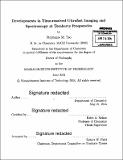| dc.contributor.advisor | Keith A. Nelson. | en_US |
| dc.contributor.author | Teo, Stephanie M | en_US |
| dc.contributor.other | Massachusetts Institute of Technology. Department of Chemistry. | en_US |
| dc.date.accessioned | 2015-01-05T20:02:03Z | |
| dc.date.available | 2015-01-05T20:02:03Z | |
| dc.date.copyright | 2014 | en_US |
| dc.date.issued | 2014 | en_US |
| dc.identifier.uri | http://hdl.handle.net/1721.1/92650 | |
| dc.description | Thesis: Ph. D., Massachusetts Institute of Technology, Department of Chemistry, 2014. | en_US |
| dc.description | Cataloged from PDF version of thesis. | en_US |
| dc.description | Includes bibliographical references (pages 231-244). | en_US |
| dc.description.abstract | Prior to the advent of high energy pulsed femtosecond lasers, the field of terahertz (THz) spectroscopy was stagnated by the lack of both high power THz sources and sensitive THz detectors. Over the past few years, it has become more 'routine' to generate and detect THz radiation between 0.1-10 THz, but there remains much room for improvement. In this work, I describe recent developments in THz detection methodology, both in a waveguide platform and in a more typical free space geometry. In the waveguide approach, THz generation, detection, and manipulation is self-contained in an on-chip system that we term the polaritonics platform, which simply consists of a single slab of an electro-optic (EO) crystal called lithium niobate. Due to the experimental geometry, we can conduct time-resolved phase-sensitive imaging of the propagating THz waves in the crystal. Alternatively, more conventional THz spectroscopy requires free space propagation between generation and detection such that a sample could be interrogated if placed between them. Within this thesis, I present improvements in spatial resolution and signal-to-noise (S/N) to two time-resolved THz imaging instruments on the polaritonics platform: phase contrast imaging and polarization gating imaging. Across both techniques, we attained a best image resolution of less than 1.5 pm (< A/100 at 0.5 THz), which is needed for studying very fine structures and near-fields in the THz regime, and a lowest noise floor of 0.12%, which is attractive for measuring small signals. We used THz imaging to explore wave behavior in metal-clad waveguide systems by employing indium tin oxide (ITO), which is a conductor at THz frequencies, but transparent at visible frequencies. We deemed ITO to behave similarly to an ideal metal, despite its low electrical conductivity. This presents the possibility of fabricating transparent THz-resonant metallic microstructures for near-field studies. Furthermore, we studied leaky wave behavior in the metal-clad waveguides, which presents a means for coupling THz radiation out of the waveguide. Lastly, I describe recent developments in free space THz detection, which traditionally consists of a time-intensive optically gated measurement in a pump-probe geometry called EO sampling. Unfortunately, this method is not conducive to measurements of irreversible processes or measurements that involve resolving an additional time axis such as in twodimensional (2D) spectroscopy experiments. In the new methodology that is discussed here, we instead acquire a THz time trace in a single laser pulse using a pair of transmission-mode glass echelon optics. We demonstrate that this single-shot method is a robust alternative to conventional scanning EO sampling that can quantitatively record THz field temporal profiles with the same S/N approximately 20 times faster than the conventional method. As a prototype 2D measurement, we applied the single-shot method to an optical pump- THz probe study of a indirect bandgap semiconductor, tin sulfide (SnS), which is currently being investigated as a material for solar cell technology. The 2D measurement made it possible to characterize carrier lifetimes and photoconductivity at THz frequencies as a function of carrier relaxation time. This initial demonstration is only the beginning of future exploration of a wide variety of systems, where we intend to extend the technique towards 2D Fourier transform THz spectroscopy to unravel behavior too complex to be resolved by linear spectra. | en_US |
| dc.description.statementofresponsibility | by Stephanie M. Teo. | en_US |
| dc.format.extent | 244 pages | en_US |
| dc.language.iso | eng | en_US |
| dc.publisher | Massachusetts Institute of Technology | en_US |
| dc.rights | M.I.T. theses are protected by copyright. They may be viewed from this source for any purpose, but reproduction or distribution in any format is prohibited without written permission. See provided URL for inquiries about permission. | en_US |
| dc.rights.uri | http://dspace.mit.edu/handle/1721.1/7582 | en_US |
| dc.subject | Chemistry. | en_US |
| dc.title | Developments in time-resolved ultrafast imaging and spectroscopy at terahertz frequencies | en_US |
| dc.type | Thesis | en_US |
| dc.description.degree | Ph. D. | en_US |
| dc.contributor.department | Massachusetts Institute of Technology. Department of Chemistry | |
| dc.identifier.oclc | 898132009 | en_US |
